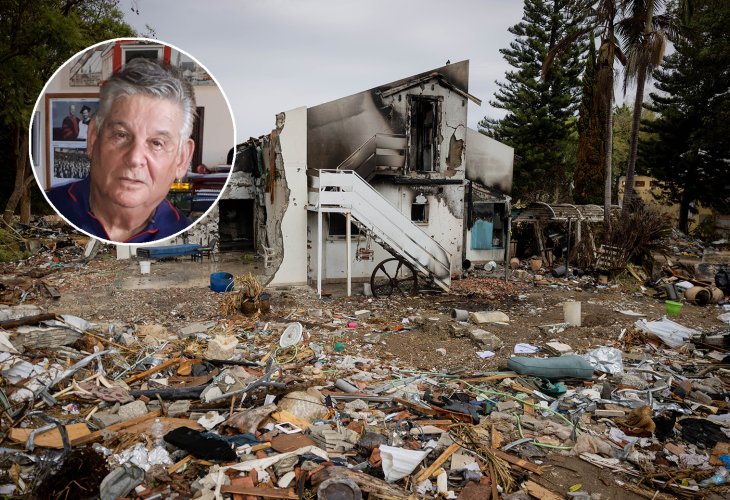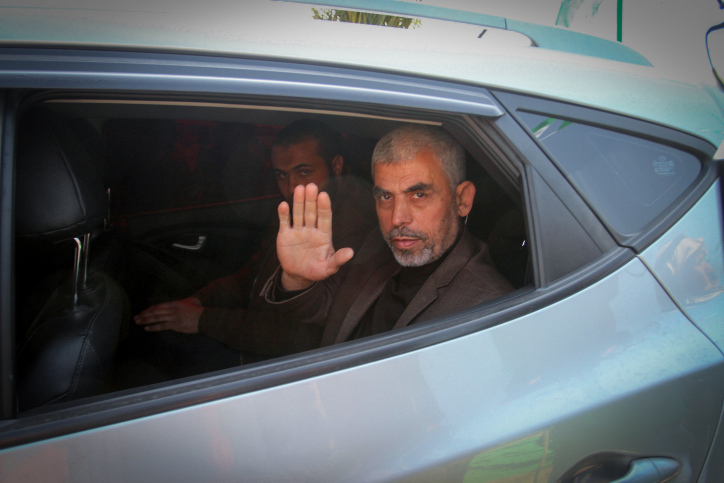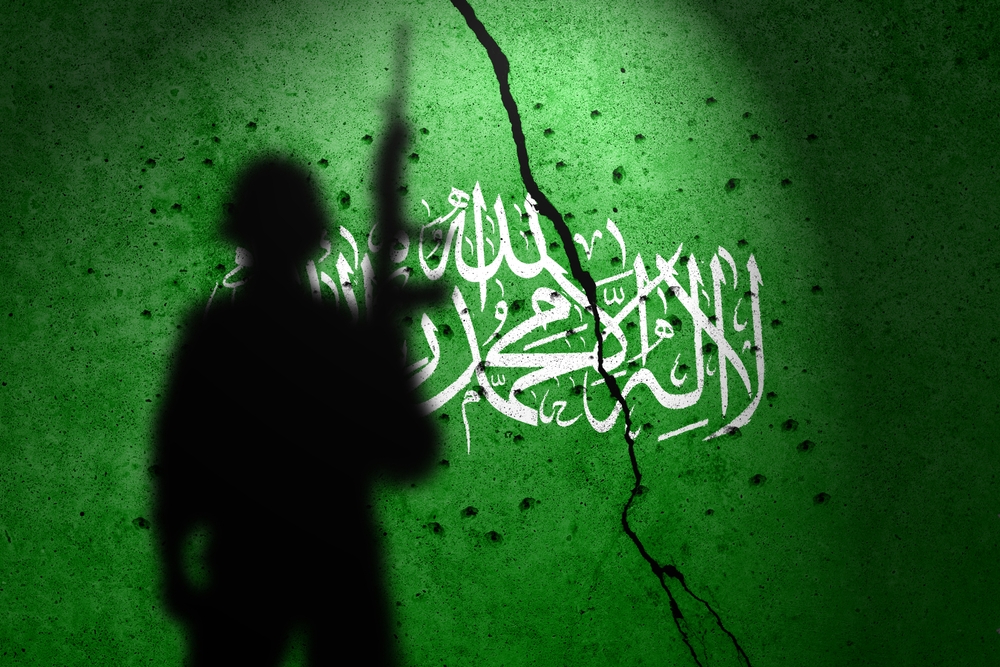Hamas' Planned Infiltration: The Inside Story
Journalist Ilan Kfir delves into the events leading to one of Israel's most severe security failures, highlighting the miracles within the tragedy.
 Inset: Ilan Kfir (Background Photo: Chaim Goldberg / Flash 90)
Inset: Ilan Kfir (Background Photo: Chaim Goldberg / Flash 90)On the morning of Shabbat when a large crowd of Gazans cheered on abandoned Israeli tanks at the Gaza Strip border, journalist Ilan Kfir was stunned by the heartbreaking images. "This collapse reminded me of the Yom Kippur War, and unfortunately, the severe consequences," he said in an interview. Two weeks after the attack, and amid growing reports of the failures leading to the tragedy, the seasoned journalist sat down to outline Israel's most serious lapse in fifty years. His findings are disturbing and thought-provoking.
"The most significant incident, in terms of recognizing the attack before it happened, was known: the night before the massacre," Kfir stated. According to him, one of the prominent indications was the mosque muezzins calling on Gazans to come to the mosques during the night. "Since when do they announce at 1 am for a 3 am gathering?" he explains, emphasizing why this immediately caught Israeli Intelligence's attention.
"Senior defense officials also identified the activation of hundreds of Israeli SIM cards in mobile phones inside Gaza. This happened simultaneously, which was particularly suspicious. Gazans have their own SIM cards; why use Israeli ones unless intending to attack in Israel?"
But the oversight actually began even earlier.
"Certainly. From my research, the issue surrounding the lookouts was the most severe. Before the Hamas attack, the bases had exceptionally experienced female lookouts. Most were nearing the end of their military service, knowing every inch of the border well. They were familiar with Hamas' actions and preparations. But no one listened to their warnings. In one case, a senior commander visited a base for a tour. The lookouts presented him with serious findings, but he dismissively waved them away."
A Brigade Without Commanders
The Israeli intelligence failure led to thousands of militants storming border settlements and the south, almost completely crippling the IDF forces in the area within a short time.
How did the IDF units collapse at the border?
"The division responsible for protecting the border is the Gaza Division. When the attack broke out, the division encountered a severe leadership issue," Kfir explains. "The division has a commander and two brigade commanders. The southern brigade commander, Assaf Hamami, was killed in the initial battles. He was among the first to encounter Hamas militants, went out to fight with some of his men, fell in battle, and his body was taken to Gaza. Hamami's actions blocked the first Hamas force's entry to Kibbutz Nirim, but they later managed to enter with their significant force against the few Israeli units in the area. Another commander was not present, being in the north, two hours away."
"Once Hamas paralyzed command and observation systems, known to be damaged at the start of the attack and some even before it, the fighters on the ground could barely manage. They lacked information on the enemy and attack scale, and didn't receive organized orders. Consequently, the air force wasn't free to operate, fearing harm to civilians. The outcome was severe."
Kfir notes that "In a sense, the main failure was over-reliance on technology. The defense establishment was enslaved to technology, costing us dearly, also due to the lack of human intelligence. Before the attack, Israel didn't have a single agent among the over a million Gazans to deliver significant information."
Was senior command completely paralyzed in the crucial initial hours?
"For a long time, they didn't know what was happening on the border and in the south. Ironically, some updates came through Hamas networks and social media. The lack of clear information led to mismanagement of forces and misunderstanding of the field reality in real time."
A Call to Be'eri
Kfir dedicates special attention in his book to military and political leaders, particularly to Prime Minister Benjamin Netanyahu: "The Prime Minister sat in a tense meeting with his team amidst the Hamas attack at noon when an aide reported that a friend, trapped in Kibbutz Be'eri, wanted to speak. The decision was to call him. That trapped friend pleaded with the Prime Minister during the call: 'Send forces, they are slaughtering us.' Netanyahu replied, 'It's being handled.'
"Despite this, no military unit was directed to the kibbutz. Fighters who reached there did so independently, guided by commanders like retired General Noam Tibon, who led forces that lost their commanders into the kibbutz. Tibon and other leaders instilled confidence in the forces to continue fighting."
"Many failed," Kfir believes. "Defense Minister Gallant, head of the political system over the army, disappeared during the attack. The poor performance of military leaders, from the Chief of Staff to staff members, is well-known. The former Intelligence Chief, who was to be a key figure the night before the attack, slept in an Eilat hotel. Apparently, his phone was off. Responding to claims against him, he said, 'No one spoke to me or woke me.' But that's a scandal in itself. As Intelligence Chief, he's responsible for Israel's intelligence apparatus and was the first to fail."
 (Photo: Tomer Neuberg / Flash90)
(Photo: Tomer Neuberg / Flash90)Failure in Stages
At this point, Kfir takes us back several years. "The failure evident to all of Israel on Shabbat began long before," he says. "Over the years, senior Israeli officials developed a theory: 'We'll feed the tiger, and it won't devour us.' Israel would feed Hamas, provide funds and financing from Qatar, and in return, Hamas wouldn't trouble Israel with rocket fire and other means.
"This theory became a concept," he notes, "Prime Minister Netanyahu and Israeli leaders erred in their approach to Hamas leader Yihya Sinwar in Gaza. He was sentenced to three life sentences in Israel for good reason. He's extremely cruel and radical. Yet, he was released in the Shalit deal. That was a historic release: one soldier for 1,027 terrorists, an exorbitant price. Such prices paid by Israel over years for its captives lead Hamas now to demand an exorbitant cost for hostages' release.
"Sinwar is smart. While in Israeli prison, he wrote a book in Hebrew, and during interrogations, he spoke Hebrew, not Arabic, knowing well Israeli thought. This allowed him to exploit it fully. This was also behind the note he sent Netanyahu after assuming leadership, offering a calculated risk: don't venture against Hamas."
 (Photo: Abed Rahim Khatib / Flash90)
(Photo: Abed Rahim Khatib / Flash90)Hamas also received significant funds with Israel's encouragement.
"Definitely. The monthly transfer of $30 million from Qatar to Hamas significantly aided in executing the attack. Hamas also profited from Palestinian workers' tax money in Israel. Israel was so captivated by Hamas' funding plan that when the group sent people to the fence shortly before the attack, the response was further increasing Qatari funding to Hamas with Israel's backing."
Do you see a connection between this failure against Hamas and the Yom Kippur War failure against Egypt and Syria?
"The leader of the theory during Yom Kippur was then Intelligence Chief Eli Zeira. Even in Israel's most critical moments, Zeira was captive to the concept. Despite receiving clear intelligence from a source in Iraq's embassy in the Soviet Union, warning on Yom Kippur night that Israel would be attacked, Zeira received it and did nothing. Later, when Egyptian and Syrian forces invaded Israel, he met with Defense Minister Dayan and Chief of Staff Dado, telling them: 'I let you sleep well at night,' meaning he didn't relay the intel. How tragic is that? To your question: the events are eerily similar."
Was there a specific way to prevent the Hamas attack without intelligence?
"On the Gaza border, two IDF brigades should have stood. No less. To counter militants, security should have placed thousands of soldiers. In reality, there were fewer than 500 fighters, who couldn't confront the surge of over 3,000 militants."
Miracle at Yad Mordechai Junction
Amid the collapse of forces and significant failures, there were many miracles, as Kfir recounts. He reveals, "Hamas militants planned a much larger mega-event. They were on their way to significant targets deep within the country. Due to censorship, I can't elaborate on specifics, but I can say Dimona was a primary target for Hamas, with all its implications. Additionally, there were two notable targets in Tel Aviv, crowded and crucial to the city, impacting its economy in at least one case.
"In fact, the militants intended to reach no less than 12 cities across Israel. Besides Tel Aviv and Dimona, they planned to attack Kiryat Gat, Ashdod, Rishon Lezion, and more, targeting Air Force bases at Hatzerim, Telmon, and Hatzor."
Did Hamas truly believe they could reach all these targets without being stopped?
"In addition to militants who penetrated Israel on Shabbat, estimated between 3,000 to 4,000, Hamas held over 3,000 more fighters ready to enter and participate in battle. Providentially, the forces' success in blocking some militants prevented the full execution of the terror group's plans. Beyond that," he emphasizes, "it was a complementary plan to the original plan, including raids on border settlements and southern towns, with the second phase poised as a follow-up if the first succeeded."
 (Photo: shutterstock)
(Photo: shutterstock)And how did Hamas' ambitious plan fail?
"Remarkably, at 11 am, police and border forces reached the Yad Mordechai junction in the south, just one minute before the militants arrived. This allowed Israeli forces to block the militants' trucks and motorcycles.
"Essentially, the militants, who had faced little resistance, were unexpectedly met by skilled forces. The South District Commander of the Israeli Police, choosing to position forces there, told me: 'We ensured not a drop of water could pass.' Thankfully, this proved effective, and the militants were stopped. Had our forces been a minute late, dozens of trucks carrying commandos would have breached deep into Israel. Another crucial blocked route was the Nevatim junction, blocking major militant plans."
Were there additional miracles during the attack?
"There were certainly events ending miraculously," he replies. "One prominent miracle occurred about ten kilometers from the Gaza Strip, where two IDF bases are located: Yarkon and Orim. The Yarkon base serves Unit 8200 (IDF Intelligence Unit). Naturally, it was a significant target for Hamas militants. Hence, Hamas sent forces to attack and gather the intelligence there. But providence led them astray."
"Undoubtedly, this miracle is one of the most notable on that dreadful day. Hamas had good intelligence, knew where to send militants, its location, and reached the area with ease. Nothing was supposed to stop them from capturing one of the IDF's most strategic bases – with all its implications. Yet, at the last moment, they diverted to the Orim base instead of Yarkon.
"And then there's 'Tequila' unit (Shin Bet commando force), which bravely operated on the ground, preventing an even greater catastrophe. The Shin Bet deployed this unit to the border the night before the attack. They were around the kibbutzim when the assault started. Despite being elite, they couldn't face the huge wave of militants alone. Nonetheless, these dozens of fighters on the ground are credited with heroic actions, greatly aiding in repelling militants and saving lives. In fact, they paid a heavy price, losing ten of their warriors, may their memory be blessed."

